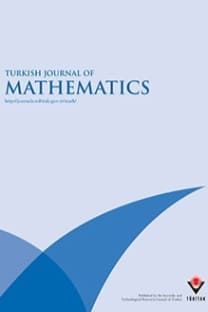Numerical investigation of viscous effects on the nonlinear Burgers equation
Numerical investigation of viscous effects on the nonlinear Burgers equation
___
- [1] Atashyar A, Khalsaraei MM, Shokri A. A new two-step hybrid singularly P-stable method for the numerical solution of second-order IVPs with oscillating solutions. Iranian Journal of Mathematical Chemistry 2020; 11 (2): 113-132.
- [2] Shokri A, Tahmourasi M. A new two-step Obrechkoff method with vanished phase-lag and some of its derivatives for the numerical solution of radial Schrödinger equation and related IVPs with oscillating solutions. Iranian Journal of Mathematical Chemistry 2017; 8 (2): 137-159.
- [3] Arabshahi MM, Golbabi A, Nikan O. Numerical approximation of time fractional advection-dispersion model arising from arising from solute transport in rivers. Turkic World Mathematical Society Journal of Pure and Applied Mathematics 2019; 10 (1): 117-131.
- [4] Xi G, Zhang W, Zhang CH. An explicit Chebyshev pseudospectral multigrid method for incompressible Navier– Stokes equations. Computers and Fluids 2010; 39 (1): 178-188.
- [5] Crighton DG. Model equations of nonlinear acoustics. Annual Review of Fluid Mechanics 1979; 11 (1): 11-33.
- [6] Bateman H. Some recent researches on the motion of fluids. Monthly Weather Review 1915; 43 (4): 163-170.
- [7] Toro EF. Reimann Solvers and Numerical Methods for Fluid Dynamics: A Practical Introduction. Berlin, Germany: Springer-Verlag, 1997.
- [8] Buck JA, Hayt WH. Engineering Electromagnetics, Vol. 6. New York, NY, USA: McGraw-Hill, 1981, pp. 445-446.
- [9] Ozisik MN. Heat Transfer: A Basic Approach, Vol. 1. New York, NY, USA: McGraw-Hill, 1985.
- [10] Metzner AB, Seyer FA. Turbulence phenomena in drag reducing systems. American Institute of Chemical Engineers 1969; 15 (3): 426-434.
- [11] Bahadır AR, Sağlam M. A mixed finite difference and boundary element approach to one-dimensional Burgers’ equation. Applied Mathematics and Computation 2005; 160 (3): 663-673.
- [12] Jiwari R, Mittal RC. Differential quadrature method for two-dimensional Burgers’ equations. International Journal for Computational Methods in Engineering Science and Mechanics 2009; 10 (6): 450-459.
- [13] Kutluay S, Bahadir AR, Özdeş A. Numerical solution of one-dimensional Burgers equation: explicit and exactexplicit finite difference methods. Journal of Computational and Applied Mathematics 1999; 103 (2): 251-261.
- [14] Bahadır AR, Saglam M. A mixed finite difference and boundary element approach to one-dimensional Burgers’ equation. Applied Mathematics and Computation 2005; 160 (3): 663-673.
- [15] Bhattacharya MC. Finite‐difference solutions of partial differential equations. Communications in Applied Numerical Methods 1990; 6 (3): 173-184.
- [16] Shih T, Qin Y. A method for estimating grid-induced errors in finite-difference and finite-volume methods. In: 41st Aerospace Sciences Meeting and Exhibit; Reno, NV, USA; 2003. p. 845.
- [17] Kutluay S, Esen A, Dag I. Numerical solutions of the Burgers’ equation by the least-squares quadratic B-spline finite element method. Journal of Computational and Applied Mathematics 2004; 167 (1): 21-33.
- [18] Alford RM, Boore DM, Kelly KR. Accuracy of finite-difference modeling of the acoustic wave equation. Geophysics 1974; 39 (6): 834-842.
- [19] Allen M, Cahn JW. A microscopic theory for antiphase boundary motion and its application to its application to antiphase domain coarsening. Acta Materialia 1979; 27: 1085-1095.
- [20] Bastain P, Shah A, Sabir M. An efficient time-stepping scheme for numerical simulation of dendritic crystal growth. European Journal of Computational Mechanics 2017; 25 (6): 475-488.
- [21] Bastian P, Birken K, Johannsen K, Lang S, Neuß N et al. UG – a flexible software toolbox for solving partial differential equations. Computing and Visualization in Science 1997; 1 (1): 27-40.
- [22] Bastian P, Heimann F, Marnach S. Generic implementation of finite element methods in the distributed and unified numerics environment (DUNE). Kybernetika 2010; 46(2): 294-315.
- [23] Chen Y, Zhang T. A weak Galerkin finite element method for Burgers’ equation. Journal of Computational and Applied Mathematics 2019; 348 (1): 103-119.
- [24] Aliev S, Gadjiev T, Galandarova S. A priori estimates for solutions to Dirichlet boundary value problems for polyharmonic equations in generalized Morrey spaces. Turkic World Mathematical Society Journal of Pure and Applied Mathematics 2018; 9 (2): 231-242.
- [25] Wang Y, Li J. Phase field modeling of defects and deformation. Acta Materialia 2010; 58: 1212-1235.
- [26] Smith JT. Conservative modeling of 3-D electromagnetic fields, Part II: biconjugate gradient solution and an accelerator. Geophysics 1996; 61 (5): 1319-1324.
- [27] Ferracina L, Spijker M. An extension and analysis of the Shu-Osher representation of Runge-Kutta methods. Mathematics of Computation 2005; 74 (249): 201-219.
- [28] Gottlieb S, Ketcheson DI, Shu CW. Strong stability preserving Runge-Kutta and multistep time discretizations. Singapore: World Scientific, 2011.
- [29] Shu CW, Osher S. Efficient implementation of essentially non-oscillatory shock-capturing schemes. Journal of Computational Physics 1988; 77 (2): 439-471.
- [30] Ding M, Shu H, Zhu H. Numerical solutions of two-dimensional Burgers’ equations by discrete Adomian decomposition method. Computers and Mathematics with Applications 2010; 60 (3): 840-848.
- ISSN: 1300-0098
- Yayın Aralığı: 6
- Yayıncı: TÜBİTAK
Polyhedral optimization of second-order discrete and differential inclusions with delay
Sevilay DEMİR SAĞLAM1, Elimhan N. MAHMUDOV
Generalized Littlewood-Paley functions on product spaces
Hussain AL-QASSEM, Leslie CHENG, Yibiao PAN
Near-rings on nearness approximation spaces
Mustafa UÇKUN, Abdurrahman GENÇ
Erdal ULUALAN, Özgün GÜRMEN ALANSAL
On the growth of maximum modulus of rational functions with prescribed poles
Numerical investigation of viscous effects on the nonlinear Burgers equation
Muhammad Imran KHAN, Abdul RAUF, Abdullah SHAH
A study of impulsive discrete Dirac system with hyperbolic eigenparameter
On the number of non-G-equivalent minimal abelian codes
İpek TUVAY, Fatma ALTUNBULAK AKSU
On the Generalization of κ-Fractional Hilfer-Katugampola Derivative with Cauchy Problem
